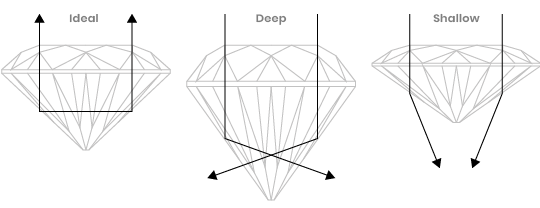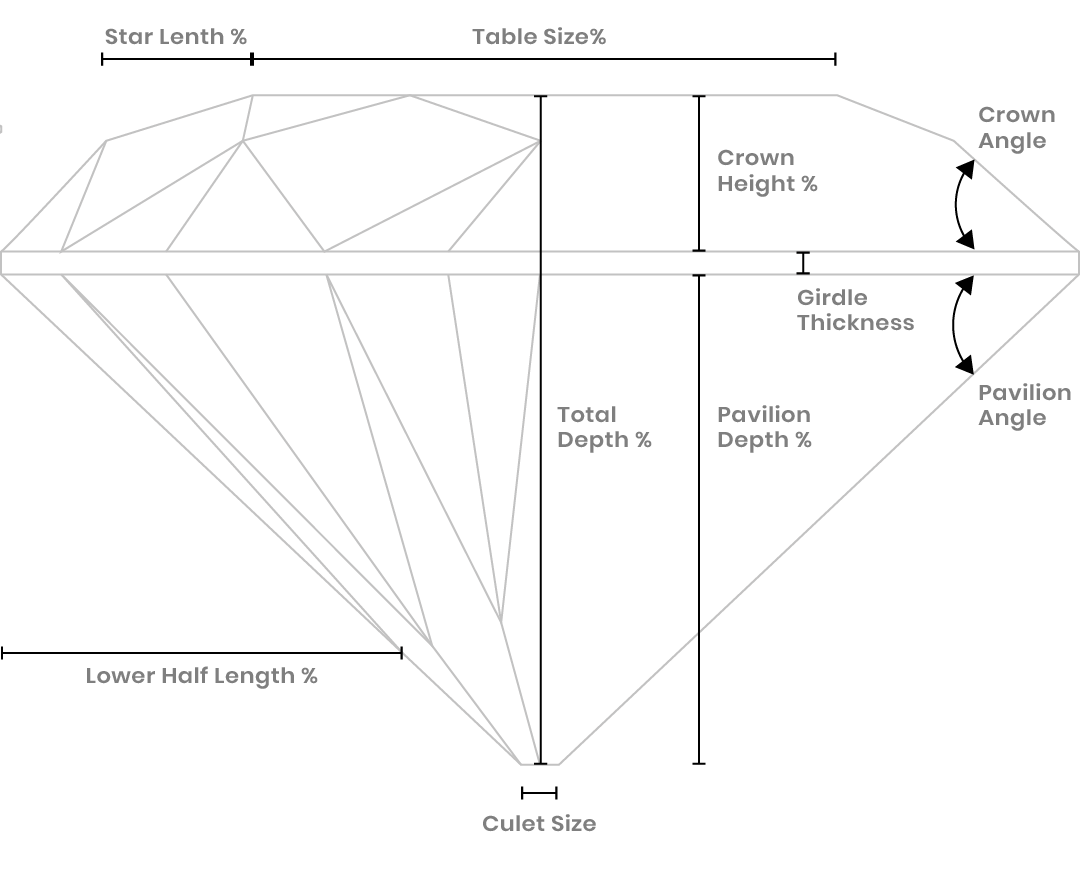Diamond Education
The 4 C'sDiamond Anatomy & Cut Quality
“Understanding diamond anatomy and cut quality is essential to choosing the perfect stone. A diamond’s brilliance depends on proportions, symmetry, and polish. From table to pavilion, every facet influences sparkle. Superior cut quality ensures maximum light reflection, making your diamond truly radiant, elegant, and timeless in beauty.”


Understanding the 4 C’s of Diamonds Shopping
“The 4 C’s—Cut, Color, Clarity, and Carat—are the foundation of diamond shopping. Each ‘C’ defines a diamond’s beauty, value, and uniqueness. By understanding these factors, you can make confident choices and select a stone that perfectly balances brilliance, quality, and personal style for any special occasion.”
Clarity
Clarity measures the purity of a diamond by evaluating internal inclusions and external blemishes. The fewer the imperfections, the rarer and more brilliant the stone appears. From Flawless to Included grades, clarity ensures transparency and beauty, helping you choose a diamond that reflects both elegance and perfection.”


Diamond Clarity Descriptions
Flawless diamonds are completely free of inclusions and blemishes under 10x magnification. Internally Flawless stones may have only minor surface marks, offering brilliance and rarity that make them highly prized.
Very Very Slightly Included (VVS1, VVS2)
VVS diamonds have extremely tiny inclusions, so small that they are difficult for skilled graders to detect. They maintain exceptional sparkle and are often considered nearly perfect to the eye.
Very Slightly Included (VS1, VS2)
These diamonds contain small inclusions visible under magnification but usually not to the naked eye. They strike a balance between quality and affordability while still providing stunning brilliance.
Slightly Included (SI1, SI2)
SI diamonds show noticeable inclusions at 10x magnification, though many remain eye-clean. They offer great value for buyers who want beauty and sparkle without the premium of higher clarity grades.
Included (I1, I2, I3)
Diamonds in this range display inclusions visible to the naked eye, sometimes affecting brilliance and durability. While more affordable, they are less rare and often chosen for budget-friendly jewelry.
Cut
Cut is the most important factor in a diamond’s beauty. It determines how light reflects, creating brilliance, fire, and sparkle. Even with perfect color and clarity, a poor cut can dull a stone. A well-cut diamond ensures maximum radiance, making it truly captivating and timeless.”


Diamond Clarity Descriptions
Flawless (FL) & Internally Flawless (IF)
Flawless diamonds are free from any inclusions or blemishes visible under 10x magnification. Internally Flawless stones may show only minor surface marks but no internal flaws. Both grades are extremely rare and admired for their purity and brilliance.
Very Very Slightly Included (VVS1, VVS2)
VVS diamonds contain minute inclusions that are almost impossible to detect, even by skilled graders. Their exceptional clarity ensures maximum sparkle, making them highly desirable for collectors and fine jewelry lovers.
Very Slightly Included (VS1, VS2)
VS diamonds display small inclusions visible under magnification but are generally invisible to the naked eye. They offer an excellent balance of quality and value, making them one of the most popular clarity choices.
Slightly Included (SI1, SI2)
SI diamonds show inclusions noticeable at 10x magnification, yet many remain eye-clean to casual observers. They provide brilliance and beauty at a more affordable price, making them ideal for those who want sparkle without overspending.
Included (I1, I2, I3)
Diamonds in this category have visible inclusions that may affect brilliance and durability. While they are the most affordable clarity grade, they can still deliver charm and size for buyers who prioritize budget over rarity.
Color
“Color in diamonds refers to the natural tint visible within the stone. The scale ranges from D (colorless) to Z (light yellow or brown). The less color a diamond shows, the rarer and more valuable it is. A colorless diamond allows maximum brilliance and pure, timeless beauty.”


Diamond Color Descriptions
Colorless (D–F)
Diamonds graded D to F are considered colorless. They appear exceptionally pure and brilliant, reflecting maximum light. These rare stones are highly prized for engagement rings and fine jewelry, offering unmatched sparkle and beauty.
Near Colorless (G–J)
G to J graded diamonds appear nearly colorless to the naked eye, with only slight traces of warmth visible under magnification. They provide an excellent balance of beauty and affordability, making them a very popular choice.
Faint Color (K–M)
Diamonds in the K to M range display a faint yellow or brown tint. While noticeable under close inspection, many still offer attractive brilliance and can be a great value option for larger stones.
Very Light Color (N–R)
These diamonds show more visible tint compared to higher grades. While less rare, they can be chosen for vintage-inspired designs or settings that complement warmer tones, offering a unique style at a budget-friendly price.
Light Color (S–Z)
Diamonds graded S to Z reveal an obvious yellow or brown shade visible to the naked eye. Though not as sought after for traditional engagement rings, they remain an affordable option for jewelry with distinctive character.
Carat (Size)
“Carat refers to a diamond’s weight, often associated with size and presence. One carat equals 200 milligrams. While larger diamonds are rarer and more valuable, carat should be considered alongside cut, color, and clarity. A well-balanced diamond ensures beauty, brilliance, and elegance beyond just its size.”


Diamond Sizing Descriptions
Small Diamonds (0.25 – 0.50 Carat)
Smaller diamonds offer delicate beauty and are often chosen for minimalist rings or accent stones. Though subtle in size, they still provide brilliance and charm, making them ideal for dainty and elegant jewelry.
Medium Diamonds (0.50 – 1.00 Carat)
This range is the most popular choice for engagement rings. A one-carat diamond is a classic standard, balancing presence, sparkle, and affordability, while still being eye-catching on the finger.
Larger Diamonds (1.00 – 2.00 Carats)
Diamonds in this size range make a bold statement with exceptional brilliance. They are highly desired for their balance between luxury and wearability, offering noticeable sparkle without being overly extravagant.
Statement Diamonds (2.00 – 3.00 Carats)
These diamonds represent luxury and status. Their larger surface area allows inclusions and color to be more visible, so higher clarity and color grades are often preferred to maintain brilliance and value.
Extra Large Diamonds (3.00+ Carats)
Diamonds above three carats are rare and command premium value. They create a striking presence and are often considered heirloom pieces, treasured for their size, rarity, and impressive brilliance.
